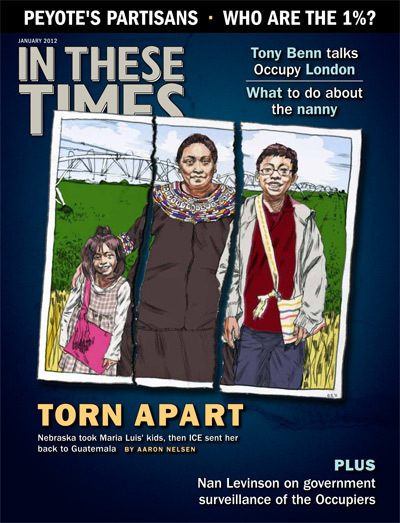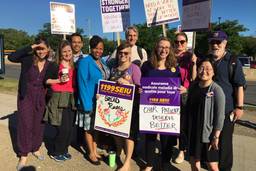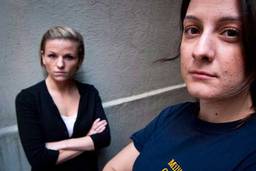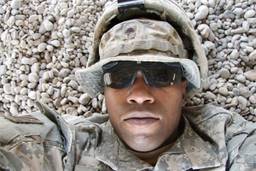Canaries in the Data Mines
Civil libertarians raise alarm over America’s national surveillance network.
Nan Levinson
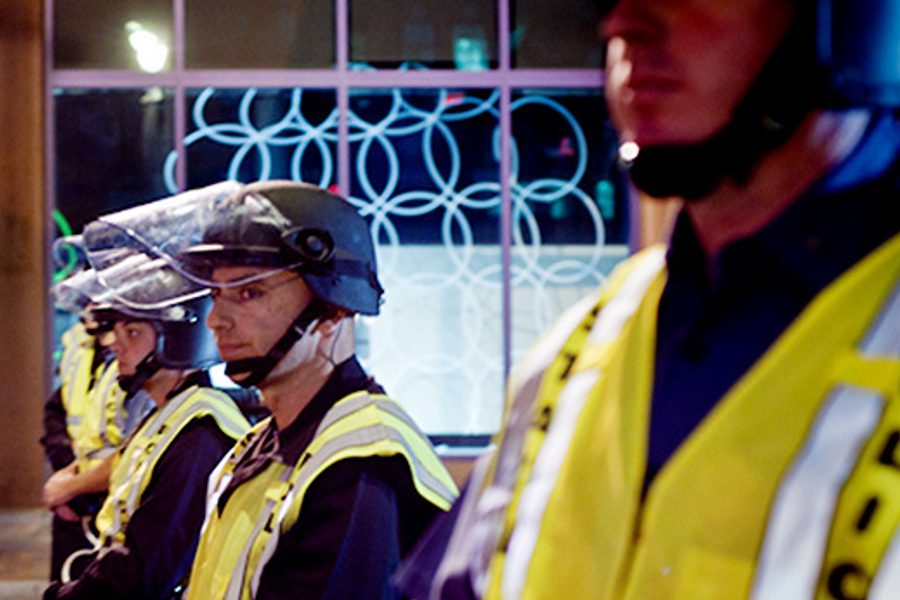
We’re going to have a little chat,” the plain-clothed officer said to Susan Barney as he fastened handcuffs around her wrists and led her from the cell at the Boston police station, where she was being held with three other political activists. It was January 2009, and they had been arrested after refusing to move from the lobby of the building that houses the Israeli consulate while taking part in a “die-in” to protest Israel’s invasion of Gaza.
This is odd, Barney thought. She had been arrested for civil disobedience several times and never before had the police wanted to chat.
Barney was led to a small room where the officer joined three other men around a table. They introduced themselves – she remembers someone from the Boston Police Department (BPD) and another from the Department of Homeland Security (DHS) – and then began questioning her about her political activities and associations. Barney, schooled in civil disobedience and keenly aware of her rights, turned her back to the table and refused to answer, but not before one of her interrogators said, “I’m sure you recognize us. We come to all your protests.” She didn’t recognize them at the time, but now reports that two of them have shown up regularly at subsequent protests, including Occupy Boston.
The Boston police had not been masking their surveillance of political actions; sometimes they were literally in the face of the protesters with their cameras. Nor was it surprising that the police were feeding information to BRIC, the Boston Regional Intelligence Center, one of 72 state and urban “fusion centers” set up a few years after 9/11 to encourage intelligence sharing among law enforcement agencies. But the more Barney and her fellow activists that day – Ridgely Fuller, Richard Hess and Patrick Keaney – thought about it, the more they wondered what happened to those reports of what they considered their constitutionally protected right to dissent.
Others were wondering too. As soon as they learned of the fusion centers, civil libertarians started asking what became of the information being amassed. They received few answers. Usually, they couldn’t even find out whom to ask. The little they were able to learn, though, indicated a universe of data collection and retention that is huge, intrusive and very secret. The unusual questioning of the four activists in 2009 offered a rare opportunity to try to dislodge information about the system and about police surveillance of political activists – a surveillance now in full flower at Occupy Boston and other Occupy encampments around the country.
About a year after Barney’s arrest, the Massachusetts chapter of the National Lawyers Guild approached the four protesters (whom they had represented in court) about filing a request under the state public records law for whatever documents the BPD kept about them or shared with other government agencies. Thus began a two-year back-and-forth, as a series of informational requests from the Guild was met by a series of feints from the Boston police, who claimed at first to have no records on the four, even though they had been arrested for civil disobedience multiple times.
Finally, the BPD released incident reports about the arrests at the Israeli consulate, which is when Urszula Masny-Latos, the Guild’s tenacious executive director, noticed a single sentence identifying the men who had interviewed the protesters as BRIC officers. She called to ask for the reports of the interviews and was told that they didn’t exist because BRIC reported only on terrorists. That raised another red flag: If those interrogations, some an hour long, didn’t merit a report, what had been their purpose, other than to let the protesters know that they were being watched?
Meanwhile, the ACLU of Massachusetts was working on a parallel track. With Political Research Associates (PRA), a local think tank, they wrote to the BPD at the end of 2009, seeking information about a pilot program at BRIC involving “suspicious activity reporting,” which apparently covered some ordinary, lawful activities. Whom did the program follow, they asked, what standards did it use, which reports were sent on to federal agencies and who monitored the system? And, by the way, what happened to the videos of political protests – a later request listed 26 of them – which the police had recorded openly? “We want a public debate about this,” says Laura Rótolo, the ACLU attorney on the case.
She too was getting nowhere. The police repeatedly refused to release the requested documents on the grounds that they were related to ongoing investigations (a claim the ACLU found dubious) or to security concerns.
Prying open government
That was apparently supposed to shut everybody up – the security claim usually does – but the ACLU and National Lawyers Guild aren’t everybody. This past August, they teamed up to sue the BPD and force release of the information they had been seeking about BRIC for the past two years. The lawsuit was filed on behalf of the four activists, PRA, and local branches of five antiwar and social justice groups – the Smedley D. Butler Brigade of Veterans For Peace, Code Pink, United for Peace and Justice, Boston Stop the Wars Coalition and the Boston Coalition for Palestinian Rights.
It was later amended to include inquiries about videos of Occupy Boston after the ACLU pinpointed about 30 surveillance cameras around Dewey Square, where the encampment was set up. The occupiers reportedly warned one another early on that if they didn’t want their picture taken, they shouldn’t be there. But aside from a regular patrol of uniformed police and the BRIC officers Barney continues to recognize, the protesters don’t know who is reporting on them or who has access to those round-the-clock videos.
The lawsuit is one of several attempts around the country to pry open the workings of fusion centers, reports about so-called “suspicious activities” and other facets of the nation’s intelligence-collecting apparatus. “We’re not saying agencies shouldn’t share information,” Rótolo says. “We’re saying there’s got to be some transparency about how they do it and some mechanism by which people can correct mistakes.” This kind of shadowy data collection system is pernicious, she says, precisely because the government makes mistakes.
Pat Scanlon, coordinator of the Smedley D. Butler Brigade, was an Army intelligence analyst in Vietnam in 1969. He spent the final months of his enlistment in the States, reviewing files of Army investigations, which taught him a lot about government surveillance.
“I’d really like to see the dossier they have on me,” he says. Citing inaccurate testimony Boston police gave after Smedley members were arrested at a Veterans Day demonstration a few years ago, he says, “We kind of know the fabrication that goes on when the police sit down to write their reports.”
Early in the morning of October 11, as Boston police arrived to evict Occupy Boston from a section of a park Democratic Mayor Thomas Menino had deemed off-limits, the veterans formed a protective cordon around the protesters, holding their flags aloft and reciting the pledge to uphold the Constitution that they took when they enlisted. Scanlon was among the first of the 141 protesters arrested, along with four other Veterans For Peace, and the Guild’s Masny-Latos, who was clearly identified as a legal observer. The Smedleys tend to be sympathetic to local police, many of whom are fellow veterans, and Occupy Boston was later granted a restraining order preventing the city from evicting the protesters from their site. But as well-intentioned as individual officers may be, once a report goes into that secret system, it is out of their hands.
At issue, then, is the right of members of the public to know what information gathering their elected leaders are conducting in their name. Also at stake is the right of individuals and groups to know who exactly is tracking their activities – not to mention everybody’s First Amendment rights to protest peacefully and to enter into public debate, rights that are threatened by this kind of unaccountable surveillance.
The BPD declined to comment on an ongoing legal case or to give permission to the director of BRIC to respond to my questions.
Data mining in alphabet soup
Amid the finger-pointing after 9/11, the failure to prevent the attacks was defined not as lack of information, but as lack of communication among the intelligence agencies collecting and analyzing the information. Metaphors of isolation – smokestacks, unconnected dots – sprang up, soon to be countered with exhortations to tear them down. Never mind that some of the dividing walls had been erected to protect citizens from government snooping: sharing became the new mantra. In 2004, the Intelligence and Terrorism Prevention Act mandated an “information sharing environment” – an arrangement related to a technofix known as “data mining.”
Data mining, as a national security tool, is based on the theory that if enough bits of disparate information are brought together, mathematical algorithms can be used to identify patterns, which can predict and preempt terrorism and other crimes. It is not a new idea. In the 1990s, the FBI monitored users of technical and science libraries, and other databases under an information “mosaic” theory, which held that researchers from hostile countries could combine discrete and benign data to create threats to American security and commerce. Since 2004, the same concept, under a different name, has been invoked to justify collecting vast amounts of information about American citizens and making that information available to local, state and federal law enforcement entities.
To call this system intricate is an understatement. The hierarchies and lines of communication and reporting are impossible to unravel, at least at this juncture, and the alphabet soup of acronyms – TIDE, TALON, TOLLS, FAST, FUSE, FIG, SWISS, RISS – reads like Dr. Seuss edited by Kafka.
The numbers that have been made public are mind-boggling: at least 800,000 local and state law enforcement officials feed information into fusion centers; some 1.5 billion records are stored in the FBI’s National Security Branch Analysis Center; about $500 million is spent on homeland security in Massachusetts alone. Bureaucracies, by their nature, bloat and sprawl, but inscrutability seems to be built into this system. If anyone understands it in its entirety, they’re not telling.
At the heart of the system are more than 71 joint terrorism task forces (JTTFs) and fusion centers. The JTTFs are supposed to investigate criminal and terrorist activity, and fusion centers are supposed to be the intelligence counterparts of the JTTFs.
There is overlap. BRIC, Boston’s fusion center, opened in 2005. Typical of urban fusion centers, it is staffed by police detectives and civilian analysts. It collaborates with state and transit police, the police forces of neighboring cities, prison officials and representatives from the business community.
Since 2008, BRIC has been one of 12 pilot sites for the Nationwide Suspicious Activity Reporting Initiative (NSI) – the program that was the focus of the initial ACLU information requests. NSI aims to standardize local police reporting of “suspicious activity” and make its Suspicious Activity Reports (SARs) available to regional and federal agencies through shared space on databases. NSI is intended to be “behavior-based” to avoid racial, ethnic and political profiling, and all fusion centers are now supposed to have privacy protection policies in place, but everything from a man using binoculars near a reservoir to the ACLU urging school superintendents in Tennessee to be sensitive to all religions during the Christmas season has shown up in SARs. And everyone from the ACLU to the Congressional Research Service has expressed reservations about how well the stipulations work.
Vast echo chamber of errors
Security is an elusive notion. It exists both as a sense of safety and as the reality of being safe; neither can be absolute. But critics charge that this kind of “intelligence-led policing” makes us less, not more, secure, by producing information that is either too broad – turning everyone into a potential suspect and undermining the trust necessary for community policing, a more effective form of social control – or too narrow, swamping law enforcement agencies with useless “noise” that distracts from genuine threats. A 2010 government evaluation found that when the Florida fusion center vetted the 5,727 SARs it collected, 12 were deemed potentially terrorism-related.
It’s a lucky person who has never had to deal with some screw-up at a government agency, whether a parking ticket or tax bill. Under the Nationwide SAR Initiative, those mistakes can spread throughout the government, be imported into commercial databases and linger in places we don’t even know exist and can’t begin to correct. Those involved in the lawsuit worry that the government is creating a vast echo chamber of errors, while providing citizens with no real means of redress.
BRIC’s privacy policy, which accords with national standards, states that individuals are entitled to review information about themselves, but then lists five exemptions, including a blanket one, making it impossible to know if the fusion center follows its own policy.
Aside from issues of effectiveness, efficiency, cost in dollars, democracy or sense of proportion – or questions of what constitutes a “credible tip” of “suspicious activity,” or the creepiness of a new technology DHS is testing that purports to discover “mal-intent” through remote sensors measuring physiological properties (see p. 10) – the core problem, insists Kade Crockford, ACLU of Massachusetts’ Privacy Rights Coordinator, is that it is wrong for a government to spy on its citizens.
Not that the groups named in the lawsuit were trying to escape notice, since even the most peaceful protest aims at provoking a response. After all, civil disobedience is meant to defy rules. And the plaintiffs are obviously not people easily cowed into silence. Ridgely Fuller, a resolute activist who likes to describe herself as “a suburban housewife,” observes wryly, “Your first arrest is kind of like the first time you have sex. It really should be memorable. After that, it’s kind of routine.”
But what of others who are more vulnerable? What about people whose job, family, finances or safety is put at risk if they attend a rally or march for a cause, and because of exercising their First Amendment rights end up in some secret government database? The lawsuit matters, Fuller argues, “because the government has a tremendous amount of control over our lives and that is a very scary thing.”
“I feel that I’m an extremely privileged individual,” Barney says. “I’ve grown up being entitled, [knowing] that I have the right to speak out. It’s a hugely wonderful privilege. I also understand that there are consequences and those consequences for people like myself at this point are getting larger and larger. I also understand that if I stay silent, if I do not continue my work in solidarity with people who are oppressed, [the authorities] have won.”
As of December 1, no one seems to be winning. The BPD responded to the lawsuit with a handful of unrevealing documents, requests for extensions, stalling tactics and a promise to produce videos that they say will resolve the case. David Kelston, the lawyer representing the Guild, is skeptical. He anticipates having to go to court to force disclosure of the information about who is watching the watchers and to move forward on the public scrutiny and open debate the plaintiffs seek.
Rótolo, who was born in Argentina and came to the United States as a young child, points to a photo she has pinned above her desk showing Jorge Rafaél Videla, the general who ruled Argentina during its “dirty war” against left-wing activists. “It just reminds me of why we do the work that we do: so that this never happens again anywhere else,” she says. “I didn’t think that I would be facing the same kind of stuff here in the United States, but here we are. We always do this ‘othering’ and don’t think it can ever happen to us. But of course it can.”
